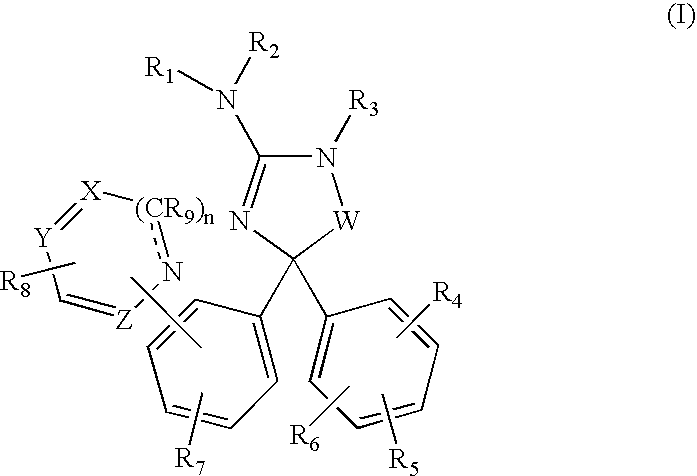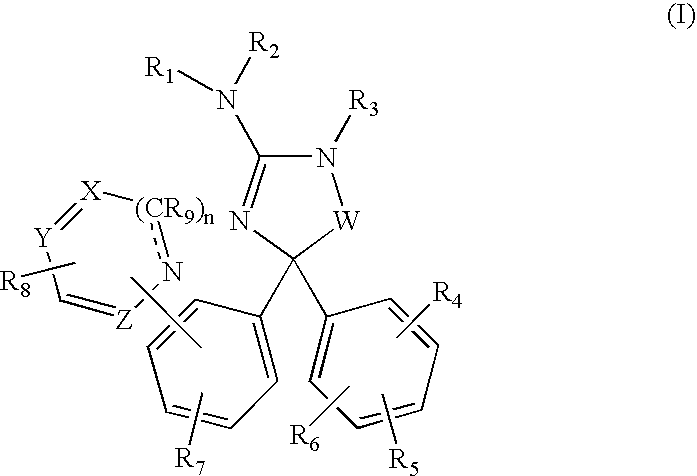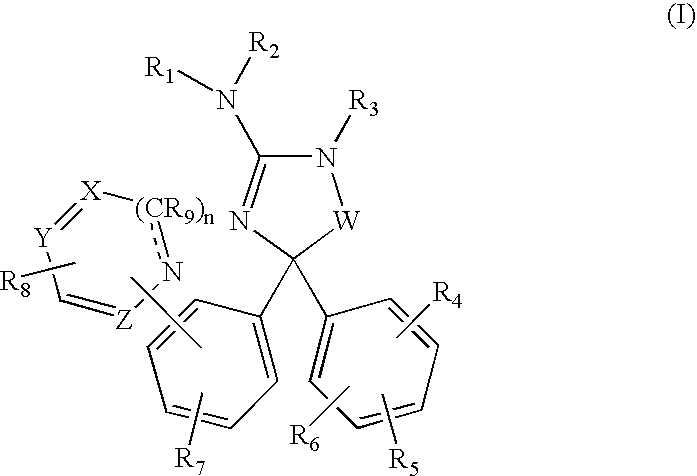Amino-5,5-diphenylimidazolone derivatives for the inhibition of β-secretase
a technology of betasecretase and amino-5,5-diphenylimidazolone, which is applied in the direction of biocide, cardiovascular disorder, drug composition, etc., can solve the problems of severe impairment, eventual death, and serious healthcare problems, and achieve the effects of improving -amyloid levels, preventing or reducing disease, and improving treatment, prevention or improving diseas
- Summary
- Abstract
- Description
- Claims
- Application Information
AI Technical Summary
Benefits of technology
Problems solved by technology
Method used
Image
Examples
example 1
Preparation of Ethyl 4-amino-3-bromobenzoate
[0110]
[0111]A solution of bromine (7.0 mL, 137.3 mmol) in dichloromethane is added dropwise to a cold (−10° C.) solution of ethyl 4-aminobenzoate (22.0 g, 133.3 mmol) in dichloromethane. The reaction mixture is allowed to come to room temperature, stirred for 18 h and diluted with water. The organic phase is separated, washed twice with brine, dried over MgSO4 and concentrated in vacuo. The resultant residue is purified by flash chromatography (SiO2, 8 / 1 hexanes / EtOAc as eluent) to afford the title compound as a white solid, 28.6 g (88% yield), identified by HNMR and mass spectral analyses. MS m / e 242 (M−H)+; 1H NMR (400 MHz, DMSO-d6) δ 1.28 (t, J=7.01 Hz, 3H), 4.22 (q, J=7.16 Hz, 2H), 6.18 (brs, 2H), 6.81 (d, J=7.91 Hz, 1H), 7.65 (dd, J=8.54, 1.98 Hz 1H), 7.89 (d, J=1.83 Hz, 1H).
example 2
Preparation of 3-Bromo-4-cyanobenzoic acid
[0112]
[0113]A solution of ethyl 4-amino-3-bromobenzoate (23.5 g, 96.3 mmol) in methylene chloride at −10° C. is treated dropwise with tert-butyl nitrite (14.0 mL, 118.4 mmol), followed by boron trifluoride diethyl etherate (18.4 mL, 146.5 mmol). The reaction mixture is allowed to come to room temperature, stirred for 4 h, diluted with ethyl ether and filtered. The filtercake is dried, dispersed in toluene, cooled to 0° C., treated with a solution of copper (I) cyanide (11.5 g, 129.2 mmol) and sodium cyanide (15.8 g, 323.1 mmol) in water, stirred at 0° C. for 30 min., warmed to 60° C., stirred for 1 h, cooled to room temperature and diluted with EtOAc and water. The organic phase is separated, dried over MgSO4 and concentrated in vacuo. The resultant residue is crystallized from ethyl ether / hexanes to give the ethyl ester of the title compound as an off-white solid, 18.6 g (76% yield). A solution of this ester (8.5 g, 33.6 mmol) in THF is tre...
example 3
Preparation of 2-Bromo-4-[(4-methoxy-3-methylphenyl)(oxo)acetyl]benzonitrile
[0114]
[0115]A suspension of 3-bromo-4-cyanobenzoic acid (1.65 g, 7.28 mmol) in thionyl chloride (10 mL) is treated with 3 drops of N,N-dimethylformamide, heated at reflux temperature for 1 h and concentrated in vacuo. This acid chloride residue is re-evaporated 3× with toluene to remove any remaining thionyl chloride. A mixture of 3-methyl-4-methoxybenzyl triphenylphosphonium chloride (6.3 g, 14.55 mmol) in toluene at 0° C. is treated dropwise with n-butyllithium (6.1 mL, 2.5 M in hexanes), allowed to come to room temperature, stirred for 2 h, cooled to 0° C., treated dropwise with a solution of the above-obtained acid chloride in toluene, allowed to come to room temperature, stirred for 2 h, quenched with water and concentrated in vacuo. The resultant residue is dispersed in acetone and water, treated with MgSO4 (7.5 g, 62.5 mmol) and KMnO4 (2.18 g, 13.8 mmol), vigorously stirred at 45° C. for 18 h and filt...
PUM
| Property | Measurement | Unit |
|---|---|---|
| temperature | aaaaa | aaaaa |
| temperature | aaaaa | aaaaa |
| temperature | aaaaa | aaaaa |
Abstract
Description
Claims
Application Information
 Login to View More
Login to View More - R&D
- Intellectual Property
- Life Sciences
- Materials
- Tech Scout
- Unparalleled Data Quality
- Higher Quality Content
- 60% Fewer Hallucinations
Browse by: Latest US Patents, China's latest patents, Technical Efficacy Thesaurus, Application Domain, Technology Topic, Popular Technical Reports.
© 2025 PatSnap. All rights reserved.Legal|Privacy policy|Modern Slavery Act Transparency Statement|Sitemap|About US| Contact US: help@patsnap.com



